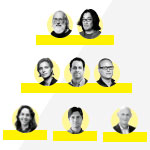Next Gen Molly Matty What worms can teach us
“Whenever I see my worms wiggle across the plate, I know I should study their movement—it’s a ‘sine’!” says the performer, Molly Matty. The audience laughs, appreciative of her pun alluding to the serpentine motion of worms as sine waves.
Pun competitions draw sold-out crowds. The rules are simple: following the given theme, make a pun within 10 seconds or you’re out. Only one person will remain to become the Pun Master.
Outside of punning, Matty spends her time as a postdoctoral researcher, studying the nematode Caenorhabditis elegans in the lab of Associate Professor Shrek Chalasani. Punsters may appreciate that the name is pronounced “see elegance.” Indeed, although these tiny worms are only half an eyelash in length, their transparent bodies allow scientists to view the worms’ inner workings, making them an elegant model organism for research. In fact, Matty’s research involves observing the worms as they consume their favorite food: bacteria.
Similar to the human gut, the C. elegans gut is in regular communication with the rest of its body, including its nervous system. Matty wants to know how ingested bacteria integrate into the worm’s gut microbiome to affect this communication.
“If different bacteria can alter the gut microbiome, then could they also affect behavior through this chain of signaling to the brain?” Matty asks.
Understanding how bacteria affect the brain and behavior could provide insights into human conditions such as anxiety and depression. These disorders may be affected, and possibly improved, by ingesting certain bacteria. In fact, the gut-behavior field is growing as more and more studies suggest a connection between food and mood.
Matty shares that C. elegans makes an ideal model for studying this connection for a few reasons: the environment (a petri dish) can be perfectly replicated, the worms self-fertilize to produce genetically similar offspring, and the microbes that they ingest are closely monitored. These factors allow for exceptionally controlled experiments that would be impossible in most other species.
Matty not only brings her humor and passion for science to the public through being punny but also by volunteering with Salk’s Education Outreach Program.
“Science outreach is the thing that keeps me going,” Matty says. “When I can break science findings down into analogies and fun vignettes for people to understand, that’s when I get inspired to go back into the lab and do the work.”
Recently, Matty visited a kindergarten class at a local elementary school, where she guided the students through the examination of worms under a microscope. She asked the students what they thought they had in common with a worm. Many students pointed out that “both worms and people poop.” Amused, Matty explained that another similarity is that nematodes have neurons that make up a series of connections similar to those of a human brain. That makes them ideal models in the study of neural circuitry related to emotion and other factors.
“Every kid should know that being a scientist is a career they can have. Scientists can look, talk and be like them,” Matty says. “Many of us deal with imposter syndrome as adults. I like to remind people: just remember, you belong here.’”
She also likes to share science through what she calls “Uber outreach.” Every time she takes a ride-hailing service, such as Uber, she incorporates science into the conversation. On one trip, she shared with her driver that she studies how the microbiome affects behavior. He happened to be studying nutrition at a local college and was immediately intrigued. The car ride turned into an open forum of questions.
“I enjoy doing ‘Uber outreach’ because it breaks down barriers. It allows members of my community to feel empowered to ask a question that they’ve always been afraid to ask,” Matty says. “And it gives me a chance to practice explaining things that I’ve maybe never had to explain before.”
Outside of her science and outreach efforts, Matty enjoys running. Every year, she runs her age in kilometers to celebrate her birthday. Since moving to San Diego, Matty has embraced the Southern California lifestyle; she has learned to surf and regularly practices yoga at one of the local studios. She also practices her puns for competition.
“I hope talking about my microbiome project didn’t ‘bug’ you too much,” Matty says, laughing.
Featured Stories
 Apart but togetherAs COVID-19 spreads across the world, organizations like the Salk Institute have mobilized to respond. In this feature article, read about how the Institute is adapting and continuing its groundbreaking science.
Apart but togetherAs COVID-19 spreads across the world, organizations like the Salk Institute have mobilized to respond. In this feature article, read about how the Institute is adapting and continuing its groundbreaking science. New COVID-19 research projectsIn addition to Salk’s ongoing research areas relevant to COVID-19, several new coronavirus-specific projects have recently launched. These innovative projects range from understanding the structure of the virus to mobilizing the body’s immune reaction.
New COVID-19 research projectsIn addition to Salk’s ongoing research areas relevant to COVID-19, several new coronavirus-specific projects have recently launched. These innovative projects range from understanding the structure of the virus to mobilizing the body’s immune reaction.
 A conversation with Martin HetzerIn the last few months, Salk Vice President and Chief Science Officer Martin Hetzer spearheaded the Institute’s efforts to respond to the pandemic from both an administrative as well as a scientific perspective.
A conversation with Martin HetzerIn the last few months, Salk Vice President and Chief Science Officer Martin Hetzer spearheaded the Institute’s efforts to respond to the pandemic from both an administrative as well as a scientific perspective.
 Eiman Azim – Decoding dexterityIn this Q&A, Assistant Professor Eiman Azim shares his thoughts on what’s next in neuroscience, how all scientists are philosophers and what he learned about movement from observing his newborn.
Eiman Azim – Decoding dexterityIn this Q&A, Assistant Professor Eiman Azim shares his thoughts on what’s next in neuroscience, how all scientists are philosophers and what he learned about movement from observing his newborn.
 Nasun Hah – Next gen sequencingAs the director of the Next Generation Sequencing Core, Staff Scientist Nasun Hah collaborates with everyone from plant biologists to neuroscientists to provide support and information about sequencing genes and entire genomes.
Nasun Hah – Next gen sequencingAs the director of the Next Generation Sequencing Core, Staff Scientist Nasun Hah collaborates with everyone from plant biologists to neuroscientists to provide support and information about sequencing genes and entire genomes. Update on initiatives to support diversity and BIPOCLearn about the Institute’s commitment to and actions around diversity and inclusion.
Update on initiatives to support diversity and BIPOCLearn about the Institute’s commitment to and actions around diversity and inclusion. Molly MattyMolly Matty, a postdoctoral researcher in the lab of Associate Professor Shrek Chalasani, shares what worms can teach us about human behavior, why science outreach is so important and why she enjoys puns.
Molly MattyMolly Matty, a postdoctoral researcher in the lab of Associate Professor Shrek Chalasani, shares what worms can teach us about human behavior, why science outreach is so important and why she enjoys puns.





















































